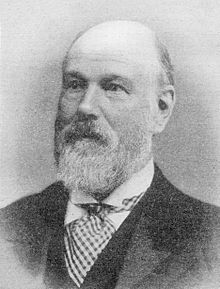Philip Pye-Smith
Philip Henry Pye-Smith | |
|---|---|
 | |
| Born | 30 August 1839 |
| Died | 23 May 1914 London |
| Nationality | English |
| Alma mater | University of London |
| Scientific career | |
| Fields | Medicine |
Dr Philip Henry Pye-Smith FRS FRCP (30 August 1839 – 23 May 1914) was an English physician, medical scientist and educator. His interest was physiology, specialising in skin diseases.[1][2]
Life
He was born in 1839 at Billiter Square, London EC3, England, the son of Ebenezer and Mary Anne Pye-Smith. He was educated at Mill Hill School and University College London before pursuing a medical career at Guy's Hospital and University of London.

In 1894 he married Emily Gertrude Foulger (1860-1923), the daughter of Arthur Foulger and Martha Barclay, founder of Walthamstow Hall, an independent girls school.
Pye-Smith died in 1914 and was buried in the family tomb at Abney Park Cemetery, Stoke Newington in north-east London. The tomb lies on the east side of the main southern path known as Dr Watt's Walk. His wife, Emily Gertrude Pye-Smith lies with him. The grave also commemorates the loss of their only child, Lieutenant Phillip Howson Guy Pye-Smith of The King's (Liverpool Regiment), who was killed during the Battle of Arras on 15 May 1917.[3]
Career highlights
- Elected a Fellow of the Royal College of Physicians in 1870.
- Elected a Fellow of the Royal Society in 1886.
- Representative to Senate of the University of London from 1902 to 1908, and was vice-chancellor from 1903 to 1905.
- Representative to the General Medical Council from 1899 to 1909.
- Presentation of Lumleian lectures "The Ætiology of Disease" in 1892.
- Presentation of Harveian Oration "Pathology as the Basis of Rational Medicine" in 1893.
- Publication: An Introduction to the study of diseases of the skin in 1893.
- Publication: Revised Principles and practice of medicine by Charles Hilton Fagge in 1888.
- Vice-chancellor of University of London
- President of the Pathological Society of London, 1907
Memorial
In St. Mark, North Audley St, Westminster there are two-stained glass windows in the memory of Philip Henry Pye-Smith.
References
- ^ "Philip Henry Pye-Smith, M.D., F.R.C.P., F.R.S". BMJ. 1 (2787): 1215–1216. 1914. doi:10.1136/bmj.1.2787.1215. PMC 2301248.
- ^ Philip Henry Pye-Smith. Royal College of Physicians of London
- ^ "Casualty". www.cwgc.org.
External links
- 1839 births
- 1914 deaths
- Fellows of the Royal Society
- English academics
- 19th-century English medical doctors
- People educated at Mill Hill School
- Burials at Abney Park Cemetery
- Fellows of the Royal College of Physicians
- Vice-Chancellors of the University of London
- Contributors to the Oxford English Dictionary
- Physicians of Guy's Hospital
